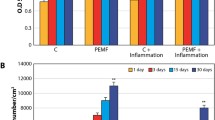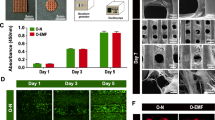Abstract
Electromagnetic fields (EMFs) are used clinically to promote fracture healing and slow down osteoporosis without knowledge of optimal parameters and underlying principles. In the present study, we investigate the effects of irritation for different durations with 15 Hz 1 mT sinusoidal EMFs (SEMFs) on rat bone marrow mesenchymal stem cells (BMSCs) proliferation, differentiation, and mineralization potentials. Our results show that SEMFs irritation promote rat BMSCs proliferation in a time-dependent manner, and the expression of osteogenic gen [Cbfa 1/RUNX2, bone sialoprotein (BSP), osteopontin (OPN)], alkaline phosphatase activity, and calcium deposition were enhanced after SEMFs treatment depending on the time duration of treatment. To determine the role of MEK/ERK signaling pathway, U0126, a MEK/ERK inhibitor was used. It can suppress rat BMSCs’ proliferation with or without SEMF exposure, and partly attenuate the expression of osteogenesis related proteins (RUNX2, BSP, OPN) which were improved by SEMF. This finding suggests that the effects of SEMF on rat BMSCs’ proliferation differentiation and mineralization are time duration dependent and MEK/ERK signaling pathway plays important role.





Similar content being viewed by others
References
Liu, H. F., Yang, L., He, H. C., Zhou, J., Liu, Y., Wang, C. Y., et al. (2013). Pulsed electromagnetic fields on postmenopausal osteoporosis in southwest China: A randomized, active-controlled clinical trial. Bioelectromagnetics, 34(4), 323–332. doi:10.1002/bem.21770.
Boyette, M. Y., & Herrera-Soto, J. A. (2012). Treatment of delayed and nonunited fractures and osteotomies with pulsed electromagnetic field in children and adolescents. Orthopedics, 35, e1051–e1055.
Assiotis, A., Sachinis, N. P., & Chalidis, B. E. (2012). Pulsed electromagnetic fields for the treatment of tibial delayed unions and nonunions. A prospective clinical study and review of the literature. Journal of Orthopaedic Surgery and Research, 7, 24.
Shi, H. F., Xiong, J., Chen, Y. X., Wang, J. F., Qiu, X. S., Wang, Y. H., et al. (2013). Early application of pulsed electromagnetic field in the treatment of postoperative delayed union of long-bone fractures: A prospective randomized controlled study. BMC Musculoskeletal Disorder, 14, 35.
Zhou, J., He, H., Yang, L., Chen, S., Guo, H., Xia, L., et al. (2012). Effects of pulsed electromagnetic fields on bone mass and Wnt/β-catenin signaling pathway in ovariectomized rats. Archives of Medical Research, 43(4), 274–282. doi:10.1016/j.arcmed.2012.06.002.
Skerry, T. M., Pead, M. J., & Lanyon, L. E. (1991). Modulation of bone loss during disuse by pulsed electromagnetic fields. Journal of Orthopaedic Research, 9, 600–608.
Chao, E. Y., Inoue, N., Koo, T. K., & Kim, Y. H. (2004). Biomechanical considerations of fracture treatment and bone quality maintenance in elderly patients and patients with osteoporosis. Clinical Orthopaedics and Related Research, 425, 12–25.
Funk, R. H., Monsees, T., & Ozkucur, N. (2009). Electromagnetic effects—From cell biology to medicine. Progress in Histochemistry and Cytochemistry, 43, 177–264.
Zhong, C., Zhang, X., Xu, Z., & He, R. (2012). Effects of low-intensity electromagnetic fields on the proliferation and differentiation of cultured mouse bone marrow stromal cells. Physical Therapy, 92, 1208–1219.
Sun, L. Y., Hsieh, D. K., Lin, P. C., Chiu, H. T., & Chiou, T. W. (2010). Pulsed electromagnetic fields accelerate proliferation and osteogenic gene expression in human bone marrow mesenchymal stem cells during osteogenic differentiation. Bioelectromagnetics, 31, 209–219.
Jansen, J. H., van der Jagt, O. P., Punt, B. J., Verhaar, J. A., van Leeuwen, J. P., Weinans, H., et al. (2010). Stimulation of osteogenic differentiation in human osteoprogenitor cells by pulsed electromagnetic fields: An in vitro study. BMC Musculoskeletal Disorder, 11, 188.
Zhou, J., Ming, L. G., Ge, B. F., Wang, J. Q., Zhu, R. Q., Wei, Z., et al. (2011). Effects of 50 Hz sinusoidal electromagnetic fields of different intensities on proliferation, differentiation and mineralization potentials of rat osteoblasts. Bone, 49, 753–761.
Yan, J., Dong, L., Zhang, B., & Qi, N. (2010). Effects of extremely low-frequency magnetic field on growth and differentiation of human mesenchymal stem cells. Electromagnetic Biology and Medicine, 29, 165–176.
Zhang, X., Zhang, J., Qu, X., & Wen, J. (2007). Effects of different extremely low-frequency electromagnetic fields on osteoblasts. Electromagnetic Biology and Medicine, 26, 167–177.
Ivancsits, S., Pilger, A., Diem, E., Jahn, O., & Rudiger, H. W. (2005). Cell type-specific genotoxic effects of intermittent extremely low-frequency electromagnetic fields. Mutation Research, 583, 184–188.
Jaiswal, R. K., Jaiswal, N., Bruder, S. P., Mbalaviele, G., Marshak, D. R., & Pittenger, M. F. (2000). Adult human mesenchymal stem cell differentiation to the osteogenic or adipogenic lineage is regulated by mitogen-activated protein kinase. Journal of Biological Chemistry, 275, 9645–9652.
Ge, C., Xiao, G., Jiang, D., & Franceschi, R. T. (2007). Critical role of the extracellular signal-regulated kinase-MAPK pathway in osteoblast differentiation and skeletal development. Journal of Cell Biology, 176, 709–718.
Sreejit, P., Dilip, K. B., & Verma, R. S. (2012). Generation of mesenchymal stem cell lines from murine bone marrow. Cell and Tissue Research, 350, 55–68.
Tondreau, T., Lagneaux, L., Dejeneffe, M., Delforge, A., Massy, M., Mortier, C., et al. (2004). Isolation of BM mesenchymal stem cells by plastic adhesion or negative selection: Phenotype, proliferation kinetics and differentiation potential. Cytotherapy, 6, 372–379.
Beyer, N. N., & Da, S. M. L. (2006). Mesenchymal stem cells: Isolation, in vitro expansion and characterization. The Handbook of Experimental Pharmacology, 174, 249–282.
Robinson, M. J., & Cobb, M. H. (1997). Mitogen-activated protein kinase pathways. Current Opinion in Cell Biology, 9, 180–186.
Griffin, X. L., Costa, M. L., Parsons, N., & Smith, N. (2011). Electromagnetic field stimulation for treating delayed union or non-union of long bone fractures in adults. Cochrane Database of Systematic Reviews, 4, CD008471. doi:10.1002/14651858.CD008471.pub2.
Gnecchi, M., & Melo, L. G. (2009). Bone marrow-derived mesenchymal stem cells: Isolation, expansion, characterization, viral transduction, and production of conditioned medium. Methods in Molecular Biology, 482, 281–294.
Comite, P., Cobianchi, L., Avanzini, M. A., Zonta, S., Mantelli, M., Achille, V., et al. (2010). Isolation and ex vivo expansion of bone marrow-derived porcine mesenchymal stromal cells: Potential for application in an experimental model of solid organ transplantation in large animals. Transplantation Proceedings, 42, 1341–1343.
Dominici, M., Le Blanc, K., Mueller, I., Slaper-Cortenbach, I., Marini, F., Krause, D., et al. (2006). Minimal criteria for defining multipotent mesenchymal stromal cells. The International Society for Cellular Therapy position statement. Cytotherapy, 8, 315–317.
Sun, L. Y., Hsieh, D. K., Yu, T. C., Chiu, H. T., Lu, S. F., Luo, G. H., et al. (2009). Effect of pulsed electromagnetic field on the proliferation and differentiation potential of human bone marrow mesenchymal stem cells. Bioelectromagnetics, 30, 251–260.
Diniz, P., Soejima, K., & Ito, G. (2002). Nitric oxide mediates the effects of pulsed electromagnetic field stimulation on the osteoblast proliferation and differentiation. Nitric Oxide, 7, 18–23.
Esposito, M., Lucariello, A., Riccio, I., Riccio, V., Esposito, V., & Riccardi, G. (2012). Differentiation of human osteoprogenitor cells increases after treatment with pulsed electromagnetic fields. In Vivo, 26, 299–304.
Zhong, C., Zhang, X., Xu, Z., & He, R. (2012). Effects of low-intensity electromagnetic fields on the proliferation and differentiation of cultured mouse bone marrow stromal cells. Physical Therapy, 92(9), 1208–1219. doi:10.2522/ptj.20110224.
de Girolamo, L., Stanco, D., Galliera, E., Vigano, M., Colombini, A., Setti, S., et al. (2013). Low frequency pulsed electromagnetic field affects proliferation, tissue-specific gene expression, and cytokines release of human tendon cells. Cell Biochemistry and Biophysics, 66(3), 697–708. doi:10.1007/s12013-013-9514-y.
Ducy, P., Zhang, R., Geoffroy, V., Ridall, A. L., & Karsenty, G. (1997). Osf2/Cbfa1: A transcriptional activator of osteoblast differentiation. Cell, 89, 747–754.
Harada, H., Tagashira, S., Fujiwara, M., Ogawa, S., Katsumata, T., Yamaguchi, A., et al. (1999). Cbfa1 isoforms exert functional differences in osteoblast differentiation. Journal of Biological Chemistry, 274, 6972–6978.
Jimenez, M. J., Balbin, M., Lopez, J. M., Alvarez, J., Komori, T., & Lopez-Otin, C. (1999). Collagenase 3 is a target of Cbfa1, a transcription factor of the runt gene family involved in bone formation. Molecular and Cellular Biology, 19, 4431–4442.
Ziros, P. G., Gil, A. P., Georgakopoulos, T., Habeos, I., Kletsas, D., Basdra, E. K., et al. (2002). The bone-specific transcriptional regulator Cbfa1 is a target of mechanical signals in osteoblastic cells. Journal of Biological Chemistry, 277, 23934–23941.
Orimo, H., & Shimada, T. (2008). The role of tissue-nonspecific alkaline phosphatase in the phosphate-induced activation of alkaline phosphatase and mineralization in SaOS-2 human osteoblast-like cells. Molecular and Cellular Biochemistry, 315, 51–60.
Balcerzak, M., Hamade, E., Zhang, L., Pikula, S., Azzar, G., Radisson, J., et al. (2003). The roles of annexins and alkaline phosphatase in mineralization process. Acta Biochimica Polonica, 50, 1019–1038.
Schonwasser, D. C., Marais, R. M., Marshall, C. J., & Parker, P. J. (1998). Activation of the mitogen-activated protein kinase/extracellular signal-regulated kinase pathway by conventional, novel, and atypical protein kinase C isotypes. Molecular and Cellular Biology, 18, 790–798.
Nie, K., & Henderson, A. (2003). MAP kinase activation in cells exposed to a 60 Hz electromagnetic field. Journal of Cellular Biochemistry, 90, 1197–1206.
Kovacic, P., & Somanathan, R. (2010). Electromagnetic fields: Mechanism, cell signaling, other bioprocesses, toxicity, radicals, antioxidants and beneficial effects. Journal of Receptors and Signal Transduction Research, 30, 214–226.
Ke, X. Q., Sun, W. J., Lu, D. Q., Fu, Y. T., & Chiang, H. (2008). 50-Hz magnetic field induces EGF-receptor clustering and activates RAS. International Journal of Radiation Biology, 84, 413–420.
Xiao, G., Jiang, D., Thomas, P., Benson, M. D., Guan, K., Karsenty, G., et al. (2000). MAPK pathways activate and phosphorylate the osteoblast-specific transcription factor, Cbfa1. Journal of Biological Chemistry, 275, 4453–4459.
Acknowledgments
The study was supported by National Natural Science Foundation of China (Grant No. 51077065).
Conflict of interest
The authors declare no conflict of interest.
Author information
Authors and Affiliations
Corresponding authors
Rights and permissions
About this article
Cite this article
Song, MY., Yu, JZ., Zhao, DM. et al. The Time-Dependent Manner of Sinusoidal Electromagnetic Fields on Rat Bone Marrow Mesenchymal Stem Cells Proliferation, Differentiation, and Mineralization. Cell Biochem Biophys 69, 47–54 (2014). https://doi.org/10.1007/s12013-013-9764-8
Published:
Issue Date:
DOI: https://doi.org/10.1007/s12013-013-9764-8




